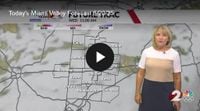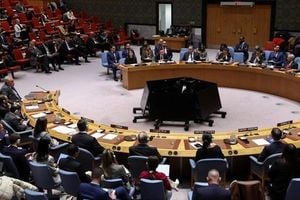South Florida residents awoke on August 20, 2025, to a sweltering and smoky morning that demanded extra caution and care. With a Heat Advisory in effect for both Broward and Miami-Dade counties from 11 a.m. to 7 p.m., the region faced a challenging combination of extreme temperatures, hazardous air quality, and reduced visibility from wildfire smoke. According to WPLG Local10.com, heat indices were forecast to soar between 105 and 110 degrees for at least two hours—a level of heat that can be dangerous for anyone exposed for prolonged periods.
But the heat was only part of the story. Early in the day, much of Broward County found itself enveloped in a haze of wildfire smoke, a direct result of inland fires and persistent northwesterly winds driving smoke into metro areas. Visibility along some roadways dropped to five miles or less in the densest pockets, prompting officials to urge motorists to exercise caution. The smoke was not only a visual nuisance but also a significant health concern, as air quality readings across much of Broward ranged from hazardous to unhealthy.
"Take breaks inside as air quality is hazardous to unhealthy for much of Broward," WPLG Local10.com advised, underscoring the risks for vulnerable groups such as children, the elderly, and those with respiratory issues. The combination of oppressive heat and poor air quality meant that outdoor activities were discouraged, and local authorities reminded residents to stay hydrated, seek air-conditioned spaces, and keep a close eye on weather updates throughout the day.
While Broward and Miami-Dade grappled with this dangerous mix, other parts of the region experienced somewhat milder—though still humid—conditions. According to local weather forecasts, August 20 was expected to be mostly cloudy, with a high near 80 degrees and a slight chance of spotty sprinkles or brief showers. "It won’t be as hot as it has been, but it will still feel humid," meteorologists noted, suggesting that while the mercury had dipped from previous highs, the air remained thick and sticky.
For those hoping for relief, the outlook for the coming days offered some promise. Humidity levels were expected to drop slightly on Thursday, August 21, with partly sunny skies and a high of 80 degrees. The improvement was forecast to continue into Friday, with partly sunny and seasonably warm conditions and a high near 86 degrees. As the weekend approached, Saturday was set to bring more typical summer warmth, but a change was on the horizon: cooler air was predicted to move in on Sunday, August 24, ushering in a spell of below-normal temperatures for the following week. "Next week will feel like fall with below normal temperatures expected," according to the forecast, giving South Floridians something to look forward to after a punishing stretch of heat and humidity.
Still, for August 20, the immediate concern remained the hazardous mix of high heat and wildfire smoke. The northwesterly wind flow, which meteorologists said would persist throughout the day, continued to funnel smoke from inland wildfires into metro Broward. The resulting haze not only obscured the skyline but also posed a real danger for drivers. "Visibilities along roadways may be reduced to 5 miles or less at times where smoke is densest," WPLG Local10.com reported, and officials urged motorists to slow down and use headlights if traveling through affected areas.
Wildfire smoke, of course, brings with it more than just poor visibility. The fine particulate matter in the smoke can aggravate existing heart and lung conditions, and even healthy individuals may experience coughing, throat irritation, or difficulty breathing. Health experts recommend staying indoors with windows closed, using air purifiers if available, and avoiding strenuous activity until air quality improves. For those who must go outside, wearing a properly fitted mask can help filter out some of the harmful particles.
Despite the warnings, some residents ventured out, whether for work, errands, or simply to see the unusual atmospheric conditions for themselves. Social media was quickly filled with photos of the sun struggling to pierce the smoky haze, and drivers reported eerie scenes of diminished visibility on major highways. The sense of unease was palpable, as many wondered how long the smoke and heat would persist—and whether the wildfires might worsen in the coming days.
The causes of the inland wildfires were not immediately detailed in official reports, but such blazes are not uncommon in Florida during the summer, when dry conditions and lightning strikes can spark fast-moving fires in grasslands and forests. The combination of drought, high temperatures, and gusty winds can quickly turn a small fire into a regional hazard. In this case, the northwesterly winds played a decisive role in transporting smoke from the interior to the coast, affecting thousands of residents who might otherwise have been spared the worst of the air quality issues.
For many in Broward and Miami-Dade, the day became a test of patience and preparedness. Schools and businesses monitored conditions closely, with some outdoor activities postponed or canceled outright. Local hospitals reported an uptick in patients experiencing respiratory distress, though most cases were mild and managed with standard treatments. Community centers and public libraries offered cool, clean spaces for those seeking refuge from the heat and smoke.
Looking ahead, officials stressed the importance of staying informed and heeding public health advisories. As the week progressed and the forecast called for drier, cooler air, there was cautious optimism that both the heat and smoke would subside. But the events of August 20 served as a stark reminder of the interconnectedness of weather, climate, and public health in South Florida—a region already accustomed to extremes, but never immune to their dangers.
As the sun set behind a smoky horizon, residents could only hope for clearer skies and cooler breezes in the days to come. Until then, the advice was simple but urgent: stay indoors when possible, drink plenty of water, and watch the skies for signs of change. In a place where the weather is always newsworthy, August 20, 2025, will be remembered as a day when nature’s power was felt in every breath and every bead of sweat.




